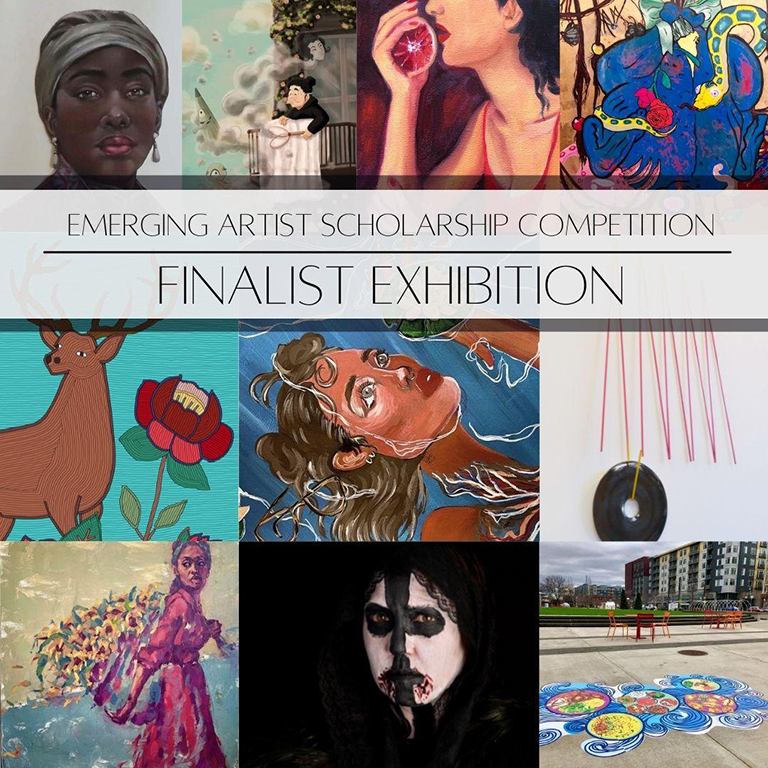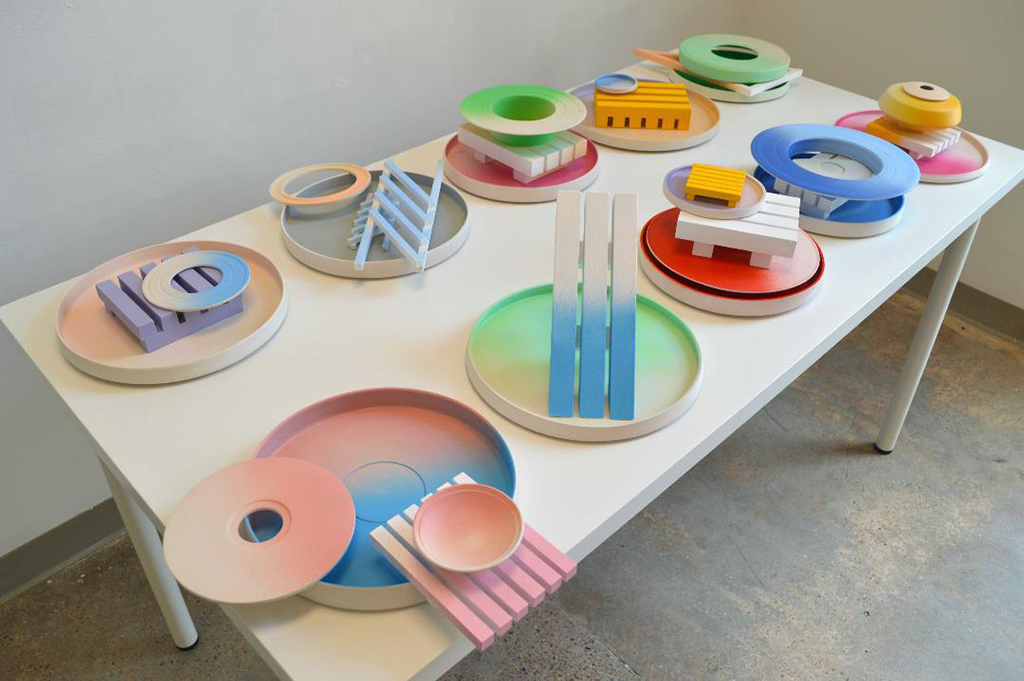By Kai Curry
Northwest Asian Weekly

Poster featuring work from each finalist (Courtesy: Gallery 110)
“We had always had in our mission…that we want to invite people who didn’t have as many opportunities,” said David Haughton, artist member of Gallery 110, where local artists have come together as a cooperative to support each other and show their art. “There was a core group of mostly old white guys,” Haughton admitted of the gallery’s origins. Enter the Emerging Artists Program, a scholarship competition in its second iteration, which gives artists a chance to benefit from gallery membership—and the gallery a chance to expand its roster.
“We had an opportunity to bring in several new people at once, new to being artists as well as new to the gallery, new perspectives for a group that had been together for a while,” member artist JoEllen Wang said. The program specifically seeks artists of color. This year, around 30 applied, which was whittled down by jurors to 10 finalists, of which up to seven will be chosen as winners of a gallery membership, career mentoring, and a guaranteed show. “We wanted Black, Indigenous, and people of color (BIPOC). We got BIPOC…all of them are good. All of them are talented,” said Haughton.

Gina Ariko’s art, such as “Teapot, 2021, deals partly with family mementos (Courtesy: Gina Ariko)
This year’s finalists include several of Asian heritage. Gina Ariko spent every other summer visiting her jichan (grandfather) and bachan (grandmother) in Fukuoka, Japan. Since both were artists, “their house would be full of art…That had a really big influence on me.” Ariko knew she wanted to be an artist, too, but thought she should wait until she felt secure. But it was the opposite. The pandemic hit, and Gina had extra time, but she also lost her jichan, with whom she had hoped to share her art, and whom she couldn’t visit due to travel restrictions.
“Losing that opportunity really lit something inside of me…It pushed me to go for it.” The works Ariko submitted to the competition, which can be viewed at www.ginaariko.com, express her desire to connect with her family and heritage during the isolation of the pandemic.

A recent work by Julian Peña, “Indulge the Tycoon.” (Credit: Julian Peña)
Julian Peña also knew art was his passion from an early age. Born in Japan, he was 12 when his mom moved to Tacoma.
“That’s when my interest in art blossomed.” A video game, anime, and Japanese woodblock print fan, Peña immersed himself in stories and visuals that would influence his art, but at first, he was too shy to show it.
“I live in fantasy worlds often, even as an adult.” UW School of Art, and a supportive high school teacher, boosted his confidence. “I was convinced that’s what I wanted to do with my life.” Peña had a gallery, but it took away from creating new art. The competition provided a chance to get back into it. Some of the works Peña prepared for the jurors are at www.jpenastudio.com.
“I love the expressions and emotions they convey. It’s very unique and it’s steeped in Japanese history.”

Sophia Fang displays some of her postcards. (Credit: Julian Peña)
Sophia Fang was born and raised in Washington. In her day job, she meets small business owners and celebrates their stories through marketing, but also watercolor postcards of store fronts. After the Atlanta shootings, she used her art to fundraise for nonprofits in Asian women’s issues. Merging art and work enables Fang to direct her passion “as a catalyst to drive social change and create action.” It has helped her realize that “art is a form of self-expression, but it’s also an aspect of community building and collaboration.” Fang showed the jurors two works from her series “Nourir” (to nurture), which focuses on “places of nourishment” around Seattle, physical, mental, or emotional, and one that “pays homage to the hyper-locality” of Pioneer Square and the Chinatown-International District. You can learn more about Fang at www.sophiafang.com.

Marie Okuma Johnston in front of one of her projects. (Credit: Julian Peña)
Marie Okuma Johnston also has a history of service. Although she had dual U.S.-Japan citizenship, she lost touch with her Japan side until age 7, when she spent summers there. As her interest in her identity grew, so did her penchant for visual art. A serendipitous work connection led her to making merchandise for the Minidoka pilgrimage committee and Minidoka itself. Along the way, she became fascinated with hanafuda, small playing cards “born out of resistance,” popular during Japanese prohibition and in U.S. incarceration camps. Johnston made a set related to the camps where inserted into a traditional Japanese scene she would put, say, a guard tower. Johnston included several works in her application dealing with Japanese folklore, some of which can be viewed at www.okumajohnston.com.

Brian Vu’s art combines repetition and improvisation. (Credit: Julian Peña)
As a minimalist in art and life, Brian Vu realizes his works are difficult to interpret compared to others.
“I don’t feel represented in fine arts or craft in general, so I feel like I’m constantly emerging.”
He grew up surrounded by his dad’s art books, which contained “a lot of eastern art…with some renaissance and impressionism mixed in.” He worried he couldn’t live off art but decided to see if he could “do the starving artist thing.” Vu’s ceramics incorporate his sense of self as a Vietnamese American, and his views on capitalism and colonialism, porcelain being a product appropriated by the Europeans. His pieces, found at www.bottegabv.com, reference everyday activities—the repetition of daily placing a coffee cup in the same spot—yet explore the improvisation or spontaneity people still retain when “getting from point A to point B.”
“I’m interested in correcting the current mix,” said Wang. “I assume/know there are good artists out there who are Black and Indigenous and Chinese and whatever. The issue is that they’re not being represented. I don’t think there’s any group that hasn’t benefited from more diversity.”
Winners will be made public June 2 and finalists’ works shown at Gallery 110 through July 2.
Kai can be reached at info@nwasianweekly.com.



